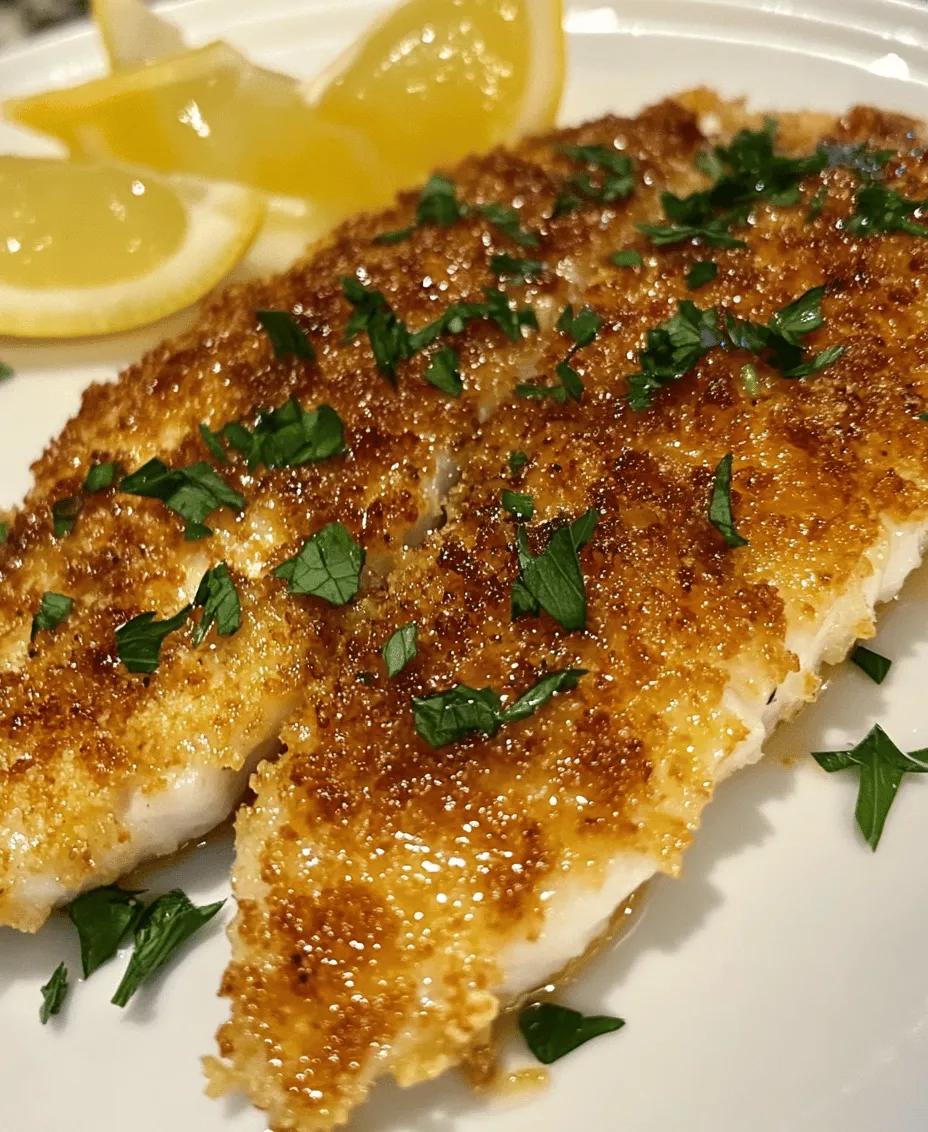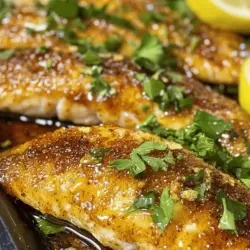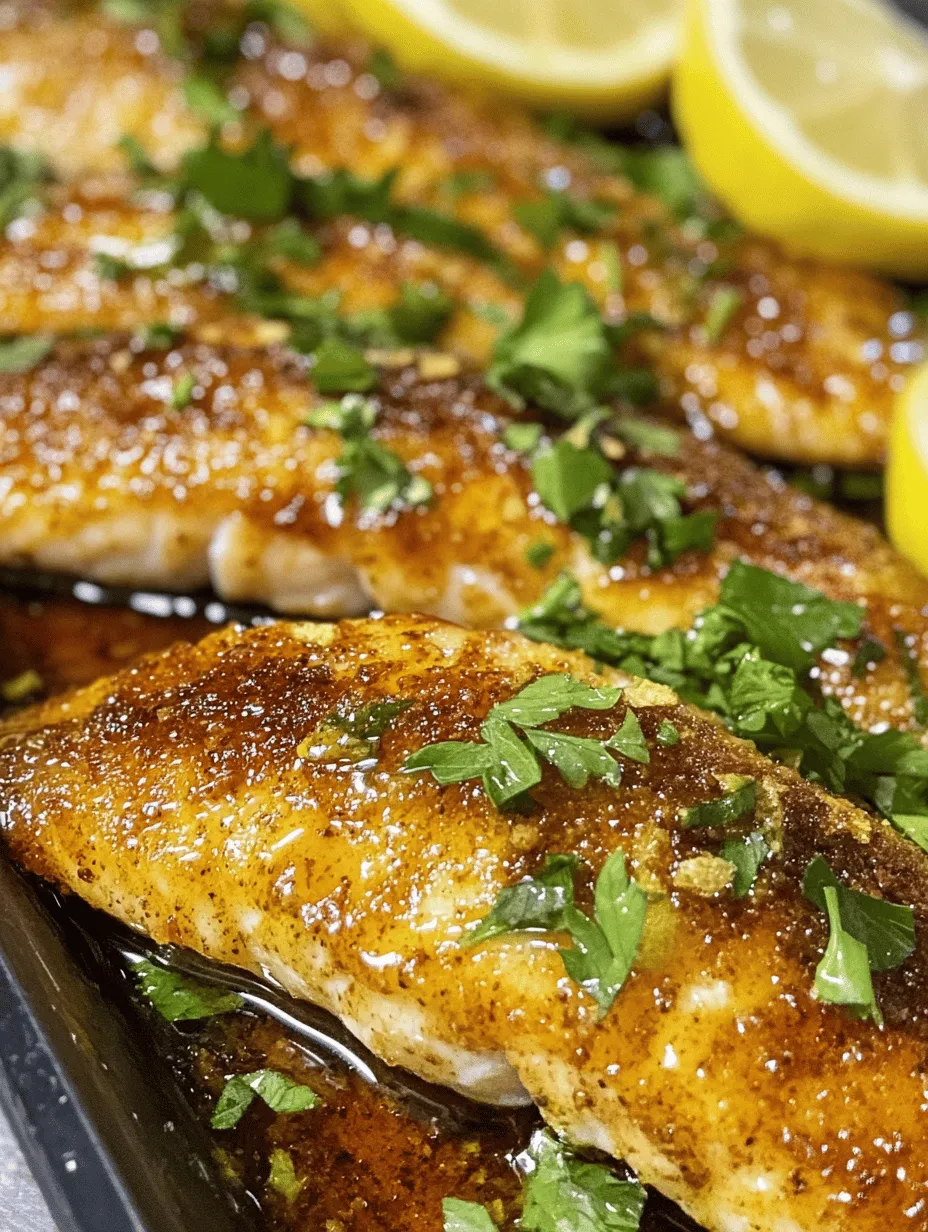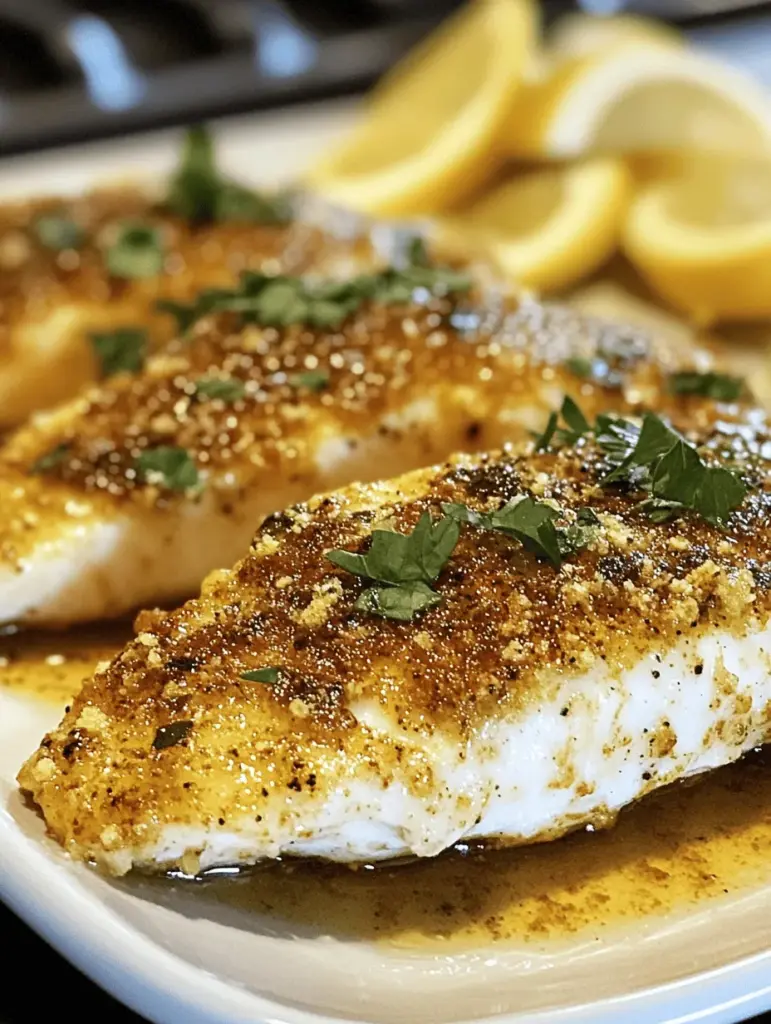Introduction
If you’re looking for a flavorful and healthy dinner option, honey mustard baked crusted tilapia fillets should be at the top of your list. This dish combines the sweetness of honey with the tanginess of Dijon mustard, creating a delicious glaze that perfectly complements the mild flavor of tilapia. The baked crust adds a delightful crunch, making each bite satisfying and enjoyable.
In today’s fast-paced world, the importance of healthy eating cannot be overstated. Incorporating fish into your diet is a great way to boost your overall health, as fish is packed with nutrients that our bodies need. Fish like tilapia can be a fantastic choice for busy weeknights, as it cooks quickly and can be prepared in numerous delicious ways.
Tilapia, in particular, is a versatile and mild-flavored fish that accommodates a variety of flavors, making it an excellent canvas for culinary creativity. Whether you are a seasoned cook or a novice in the kitchen, this honey mustard baked crusted tilapia recipe will impress your family and friends while also aligning with your healthy eating goals.
Understanding Tilapia
Nutritional Profile of Tilapia
Tilapia is not only delicious but also offers a wealth of nutritional benefits. This fish is considered a lean protein source, making it an ideal choice for those looking to maintain a healthy weight or build muscle. A 3-ounce serving of tilapia contains around 22 grams of protein, which is essential for muscle repair and growth.
Low-Calorie Benefits
One of the most appealing aspects of tilapia is its low-calorie count. With only about 110 calories per 3-ounce serving, tilapia can be part of a weight management plan without compromising on flavor or satisfaction.
High Protein Content
As mentioned earlier, tilapia is rich in protein. Protein is crucial for numerous bodily functions, including hormone production, immune function, and tissue repair. Incorporating protein-rich foods like tilapia into your diet can help keep you feeling full and satisfied for longer.
Omega-3 and Omega-6 Fatty Acids
While tilapia isn’t as high in omega-3 fatty acids as fatty fish like salmon, it still contains a healthy balance of omega-3 and omega-6 fatty acids. These essential fats play a vital role in heart health, brain function, and reducing inflammation in the body. Including tilapia in your meals can contribute to a well-rounded intake of these important nutrients.
Sustainable Seafood Choices
Choosing environmentally responsible seafood is essential for the health of our oceans and the future of our food supply. When it comes to tilapia, understanding its sourcing is key.
Importance of Choosing Responsibly Sourced Fish
Opting for responsibly sourced tilapia ensures that you are making a sustainable choice. Overfishing and harmful fishing practices can deplete fish populations and damage marine ecosystems. Look for tilapia that is certified by organizations such as the Marine Stewardship Council (MSC) or the Aquaculture Stewardship Council (ASC), which indicates that the fish has been harvested or farmed sustainably.
Overview of Tilapia Farming Practices
Most tilapia available in the market today is farmed, primarily in countries like China, Indonesia, and the Philippines. While farmed tilapia can be a more sustainable option, it’s still crucial to ensure that the farms adhere to responsible practices. Look for tilapia that is sourced from farms that prioritize water quality, fish health, and minimal environmental impact.
Ingredients Breakdown
Now that we have established the importance of tilapia in a healthy diet, let’s dive into the ingredients that make this honey mustard baked crusted tilapia fillets recipe truly special.
Tilapia Fillets: Sourcing and Selection Tips
When selecting tilapia fillets, freshness is key. Look for fillets that have a mild odor (not fishy), firm texture, and a moist appearance. If buying frozen tilapia, ensure that the packaging is intact and free from ice crystals, which can indicate thawing and refreezing. Farmed tilapia is often preferable due to its consistent quality and availability.
Honey: Types and Health Benefits
For this recipe, you can use various types of honey, depending on your taste preferences. Clover honey is the most common, while wildflower honey offers a blend of flavors from different flowers. Honey is not only a natural sweetener but also contains antioxidants, which can help reduce inflammation and improve overall health.
Dijon Mustard: Flavor Profile and Alternatives
Dijon mustard adds a tangy and slightly spicy flavor that balances beautifully with the sweetness of honey. If you don’t have Dijon mustard on hand, yellow mustard can be used as a substitute, though it will impart a milder taste. For a more adventurous flavor, consider using spicy brown mustard or whole grain mustard.
Panko Breadcrumbs vs. Regular Breadcrumbs
Panko breadcrumbs are a Japanese-style breadcrumb that is coarser and lighter than traditional breadcrumbs. They create a crispier texture when baked, making them ideal for this dish. If you can’t find panko, regular breadcrumbs can be substituted, but the texture may not be as crunchy.
Spices: Garlic Powder, Smoked Paprika, and Their Flavor Contributions
Garlic powder adds a savory depth to the dish, while smoked paprika contributes a subtle smokiness that enhances the overall flavor profile. Both spices work harmoniously to elevate the taste of the tilapia fillets. Feel free to experiment with other spices such as cayenne pepper for heat or Italian seasoning for an herbaceous twist.
Importance of Fresh Herbs and Lemon for Garnish and Flavor Enhancement
Fresh herbs, such as parsley or dill, can brighten up the dish and add a pop of color. A squeeze of fresh lemon juice before serving adds acidity and freshness that can help balance the flavors. Not only do these garnishes enhance the visual appeal of the dish, but they also elevate the overall taste.
Preparation Steps
Now that we have covered the ingredients, let’s walk through the preparation steps to create your honey mustard baked crusted tilapia fillets.
Step 1: Preheat Your Oven
Begin by preheating your oven to 400°F (200°C). This ensures that your fish will cook evenly and develop a golden crust.
Step 2: Prepare the Baking Sheet
Line a baking sheet with parchment paper or foil. This will help prevent the fish from sticking and make for easier cleanup later.
Step 3: Make the Honey Mustard Mixture
In a small bowl, combine equal parts honey and Dijon mustard. Depending on your taste preference, you might want to adjust the ratio slightly. For a sweeter glaze, add more honey; for a tangier flavor, increase the mustard. Mix until well combined and set aside.
Step 4: Season the Tilapia
Place the tilapia fillets on the prepared baking sheet. Season both sides with salt, pepper, garlic powder, and smoked paprika. This will enhance the flavor of the fish and create a delicious base for the crust.
Step 5: Apply the Honey Mustard Glaze
Using a brush or spoon, generously coat the top of each tilapia fillet with the honey mustard mixture. Be sure to cover the entire surface for maximum flavor.
Step 6: Add the Panko Crust
Sprinkle panko breadcrumbs evenly over the glazed fish. Gently press the breadcrumbs down to ensure they adhere to the honey mustard mixture. This step is crucial for achieving a crispy crust when baking.
Step 7: Bake the Tilapia
Place your baking sheet in the preheated oven and bake for approximately 12-15 minutes, or until the fish flakes easily with a fork and the crust is golden brown. The cooking time may vary depending on the thickness of your fillets, so keep an eye on them to avoid overcooking.
Step 8: Garnish and Serve
Once the tilapia is done baking, remove it from the oven and let it rest for a couple of minutes. Just before serving, garnish with fresh herbs and a squeeze of lemon juice for an extra burst of flavor.
With these preparation steps, you are well on your way to enjoying a delicious and healthy meal that is sure to satisfy your taste buds. The combination of honey and mustard creates a unique flavor profile that pairs beautifully with the tender tilapia, making it a standout dish for any occasion.
Stay tuned for the next part of this article, where we will explore tips for best results, common questions, and serving suggestions to enhance your dining experience!

Preheating the Oven: Why It Matters
Before diving into the preparation of your Honey Mustard Baked Crusted Tilapia Fillets, it’s essential to preheat your oven to 400°F (200°C). Preheating is a critical step in baking because it ensures that your fish cooks evenly, preventing it from becoming rubbery or dry. An adequately preheated oven allows the honey mustard mixture to caramelize beautifully, creating a flavorful crust that locks in moisture. This step not only enhances the texture but also the overall taste of the dish, making it an essential part of the cooking process.
Making the Honey Mustard Mixture: Techniques for Blending Flavors
Creating the honey mustard mixture is simple yet crucial for achieving a deliciously balanced flavor profile. Start by combining ¼ cup of honey with 2 tablespoons of Dijon mustard in a mixing bowl. For an added kick, consider incorporating a dash of cayenne pepper or a teaspoon of apple cider vinegar. Whisk the ingredients together until they form a smooth, cohesive blend. The key here is to taste as you go; the sweetness of the honey should complement the tangy mustard without overpowering it. This mixture serves not only as a marinade but also as a glaze that enhances the tilapia’s natural flavors.
Crafting the Breadcrumb Coating: Ensuring the Perfect Texture
Next, focus on creating the breadcrumb coating that will give your tilapia its delightful crunch. In a separate bowl, mix 1 cup of plain breadcrumbs (you can also use panko for an extra crispy texture) with ¼ cup of grated Parmesan cheese, 1 teaspoon of garlic powder, and a pinch of salt and pepper. Toss these ingredients together until well combined. The cheese adds a rich flavor, while the garlic powder imparts a savory depth. If you’re feeling adventurous, consider adding dried herbs like parsley or thyme for an aromatic touch. The result should be a dry, crumbly mixture that will cling beautifully to the fish.
Coating the Tilapia: Tips for an Even Application
Now comes the fun part—coating your tilapia fillets. Begin by patting the fillets dry with a paper towel to remove excess moisture, which will help the coating adhere better. Using a pastry brush or the back of a spoon, generously apply the honey mustard mixture to one side of the fillet. Take your time to ensure an even coating, as this will affect both flavor and texture. Once coated, press the fillet, mustard-side down, into the breadcrumb mixture, ensuring that it is well covered. Flip the fillet and repeat the process on the other side. Place the coated fillets on a greased baking sheet, making sure they are spaced apart to allow even cooking.
Baking the Perfect Tilapia
Optimal Baking Temperature and Time
With your oven preheated and tilapia coated, it’s time to bake. Place the baking sheet in the oven and let the fillets bake for about 12-15 minutes. The exact time may vary depending on the thickness of your fillets, so keep an eye on them as they cook. The goal is to achieve a beautifully golden brown crust while ensuring the fish remains tender and flaky inside.
Signs of Doneness: How to Check if Tilapia is Cooked Properly
To determine if your tilapia is done, use a fork to gently flake the thickest part of the fillet. The fish should flake easily and appear opaque, with a slightly translucent center. If the flesh is still translucent and resists flaking, give it a few more minutes in the oven. Remember, tilapia cooks quickly, so avoid overcooking to maintain its delicate texture.
Achieving a Golden Brown Crust: Tips for Getting It Right
For that perfect golden brown crust, consider placing the baking sheet under the broiler for the last 1-2 minutes of cooking. Keep a close watch to prevent burning. This step caramelizes the honey mustard glaze and adds an extra layer of crunch to the breadcrumbs. If your oven has a convection setting, you can also use that to circulate hot air around the fish, promoting even browning.
Serving Suggestions
Creative Ways to Serve the Baked Tilapia
Once your Honey Mustard Baked Crusted Tilapia Fillets are ready, it’s time to think about presentation. Serve the fillets on a large platter, garnished with fresh herbs like parsley or cilantro for a pop of color. A squeeze of lemon juice over the top can enhance the flavors, cutting through the sweetness of the honey.
Pairing with Side Dishes: Vegetables, Grains, and Salads
This dish pairs beautifully with a variety of side dishes. Consider serving it alongside roasted vegetables, such as asparagus or Brussels sprouts, which add a lovely crunch and complement the fish’s flavors. For a heartier option, fluffy quinoa or brown rice can provide a nutritious base. A fresh salad with mixed greens, cherry tomatoes, and a light vinaigrette also makes for a refreshing accompaniment.
Ideas for Sauces and Dips That Complement the Dish
While the honey mustard glaze is delightful on its own, you can elevate your meal with additional sauces. A zesty tartar sauce or a creamy dill sauce can add a tangy contrast to the sweetness of the fish. For those who enjoy a bit of heat, a spicy aioli or sriracha mayo can also be a fantastic pairing.
Presentation Tips for a Restaurant-Quality Meal at Home
To achieve a restaurant-quality presentation, consider plating each fillet on individual plates with a small serving of sides. Drizzle the plate with a balsamic reduction or a herb-infused olive oil for an elegant touch. Adding a few edible flowers or microgreens can also elevate the visual appeal, making your meal feel special and inviting.
Health Benefits of the Dish
Overview of the Health Benefits of the Ingredients
The Honey Mustard Baked Crusted Tilapia Fillets are not only delicious but also packed with health benefits. Tilapia is a lean protein source, making it an excellent choice for those looking to maintain a healthy diet. It is low in calories and high in essential nutrients, including vitamin B12, selenium, and phosphorus.
Antioxidants from Honey and Spices
Honey, a key ingredient in this recipe, is known for its antioxidant properties, helping to combat oxidative stress in the body. Its natural sweetness can satisfy cravings for sugar without the negative effects of processed sugars. The mustard adds beneficial compounds, including glucosinolates, which may help reduce inflammation.
The Importance of Omega-3 Fatty Acids in Fish
While tilapia is lower in omega-3 fatty acids compared to fatty fish like salmon, it still provides a good source of these essential fats, which are crucial for heart health and brain function. Incorporating a variety of fish into your diet can help ensure you receive adequate levels of omega-3s.
How This Recipe Supports a Balanced Diet
This recipe supports a balanced diet by providing a healthy dose of protein and essential nutrients while remaining low in fat and calories. By pairing the tilapia with nutrient-rich sides such as vegetables and whole grains, you can create a wholesome meal that satisfies both hunger and health goals.
Conclusion
The Honey Mustard Baked Crusted Tilapia Fillets offer a delightful combination of flavors and textures that make them a fantastic choice for a quick yet impressive meal. With their health benefits and ease of preparation, they are perfect for busy weeknights or special occasions alike. The recipe allows for creativity, whether through side dishes, sauces, or presentation, ensuring that you can tailor it to your taste and dietary preferences.
Incorporating more seafood into your regular meal planning can significantly enhance your diet, providing essential nutrients and promoting overall health. So why not give this recipe a try? You’re sure to enjoy the delicious results and may find a new favorite that brings the joy of cooking and eating into your home.


